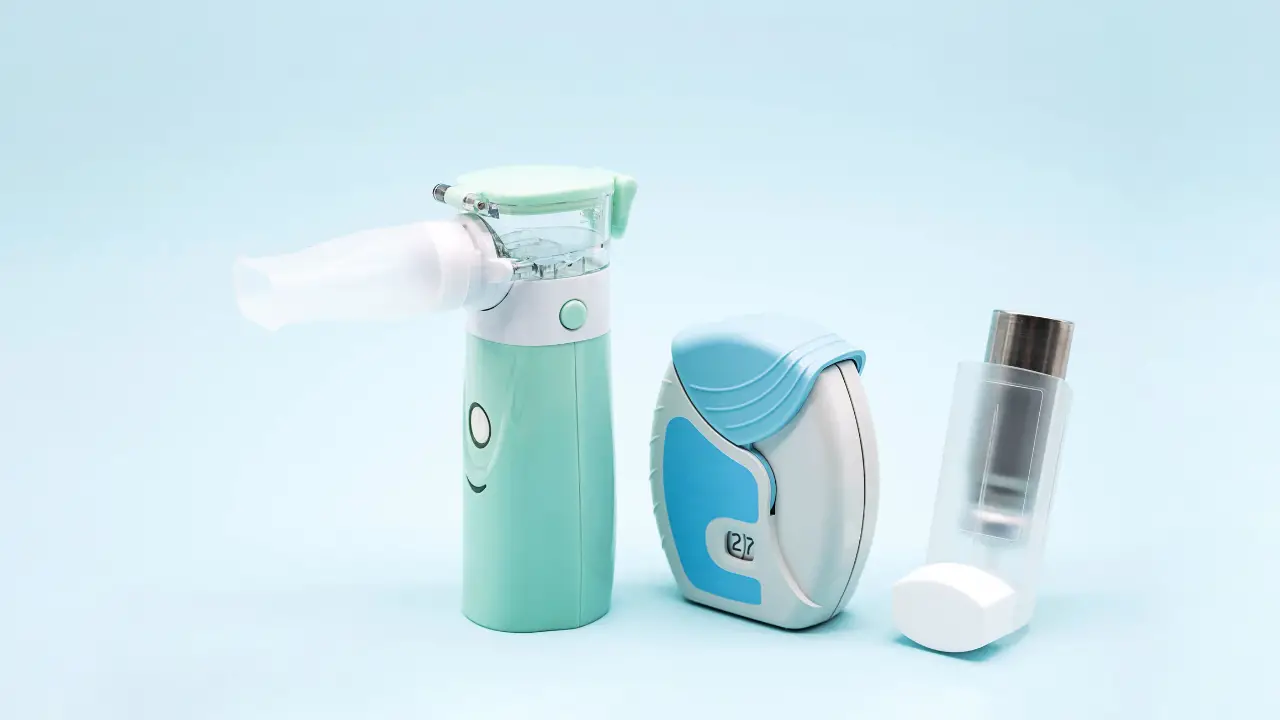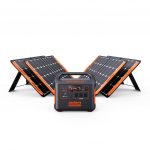Smart inhalers offer advanced technology for managing asthma, providing a new level of control and convenience. The National Asthma Education and Prevention Program recommends their use as they have been shown to improve asthma control and reduce the number of exacerbations.
With the SMART (Single Maintenance and Reliever Therapy) approach, the same inhaler is used for both prevention and rescue therapy, combining a corticosteroid and a long-acting beta agonist. This approach ensures that additional steroid medication is available during times of increased symptoms, while also enabling lower daily doses of inhaled steroids. SMART therapy can improve adherence and eliminate medication confusion, making it an effective option for patients with moderate persistent asthma that is not well controlled with low-dose steroids.
However, it is important to note that SMART may not be suitable for patients who overuse their rescue inhalers. Proper evaluation and individualized treatment plans are necessary to determine the best approach for managing asthma in such cases. Additionally, the availability of different formulations, such as those using budesonide or mometasone as the preventive component and formoterol as the rescue component, offers personalized options for asthma management.
Diagnostic testing, such as spirometry and Fractional Exhaled Nitric Oxide (FeNO) testing, can provide valuable information for the diagnosis and monitoring of asthma. These tests play a crucial role in optimizing treatment plans and ensuring the best outcomes for patients.
Informing patients and their parents about the streamlined approach of SMART therapy is essential. It is important to ensure that relevant healthcare providers are aware of the use of a single maintenance and reliever inhaler, allowing for effective collaboration and communication in managing asthma.
Table of Contents
Key Takeaways:
- Smart inhalers offer advanced technology for managing asthma, improving control and convenience.
- The SMART approach involves using the same inhaler for both prevention and rescue therapy.
- SMART therapy can improve adherence and eliminate medication confusion.
- It is suitable for patients with moderate persistent asthma that is not well controlled with low-dose steroids.
- Diagnostic testing, such as spirometry and FeNO testing, can provide valuable information for diagnosis and monitoring.

The Importance of Inhaler Technology
Inhaler technology has transformed asthma management, offering innovative solutions for improved respiratory care. With the advent of smart inhalers, patients now have access to advanced features that can enhance their treatment outcomes and overall well-being.
- Connected inhalers allow for remote monitoring, providing healthcare providers with real-time data on medication usage and adherence. This allows for better tracking of asthma control and the ability to intervene promptly if symptoms worsen.
- Smart inhalers also offer personalized reminders and alerts, ensuring that patients take their medication as prescribed. This can significantly improve adherence and reduce the risk of exacerbations.
- Furthermore, inhaler technology has made it easier for patients to track their symptoms and triggers, providing valuable insights for both patients and their healthcare providers in managing their asthma more effectively.
In addition to these benefits, inhaler technology has also led to the development of inhalers with improved delivery systems, ensuring that the medication reaches the lungs more effectively. This can result in better asthma control and reduced reliance on rescue medications.
Table: Comparison of Traditional Inhalers and Smart Inhalers
| Traditional Inhalers | Smart Inhalers |
|---|---|
| Basic inhalation technique | Real-time inhalation feedback |
| No data tracking | Remote monitoring and data collection |
| No medication reminders | Personalized reminders and alerts |
| No symptom tracking | Ability to track symptoms and triggers |
| Variable medication delivery | Improved medication delivery |
Overall, inhaler technology plays a crucial role in asthma management, empowering patients to take control of their respiratory health. By utilizing the capabilities of smart inhalers, patients can experience improved medication adherence, enhanced asthma control, and a better quality of life.
The SMART Approach to Asthma Control
The SMART approach to asthma control revolutionizes treatment by combining prevention and rescue therapy in a single inhaler. This innovative method, recommended by the National Asthma Education and Prevention Program, offers improved asthma control and reduces the number of exacerbations. SMART stands for Single Maintenance and Reliever Therapy, which entails using the same inhaler to deliver a combination of a corticosteroid and a long-acting beta agonist.
The SMART approach involves providing additional steroid medication during times of increased symptoms, allowing for lower daily doses of inhaled steroids. This not only helps in managing asthma symptoms effectively but also improves adherence to the prescribed treatment plan and eliminates any confusion regarding separate medications for prevention and rescue.
The SMART approach is suitable for patients aged 5 and older with moderate persistent asthma that is not well controlled with low-dose steroids. However, it may not be appropriate for patients who habitually overuse their rescue inhalers. Therefore, proper evaluation and assessment of the individual’s condition are essential before initiating SMART therapy.
The Benefits of SMART Therapy
- Improved asthma control
- Reduction in exacerbations
- Enhanced patient adherence
By utilizing smart inhalers and implementing the SMART approach, individuals with asthma can experience significant improvements in their respiratory health. These inhalers, available in two main formulations using budesonide or mometasone as the preventive component and formoterol as the rescue component, allow for personalized asthma management according to a patient’s needs and preferences.
Furthermore, diagnostic testing for asthma, such as spirometry and Fractional Exhaled Nitric Oxide (FeNO) testing, can be incredibly helpful in diagnosing and monitoring the condition. These tests provide valuable insights into lung function and inflammation, enabling healthcare providers to optimize asthma treatment plans and ensure the best possible outcomes for patients.
Informing patients and their parents about the streamlined approach of SMART therapy is crucial for effective asthma management. Additionally, healthcare providers should be made aware of the use of a single maintenance and reliever inhaler to ensure seamless coordination and collaboration in delivering optimal care.
| Advantages of SMART Therapy |
|---|
| Improved asthma control |
| Reduction in exacerbations |
| Enhanced patient adherence |
Suitable Candidates for SMART
SMART therapy is suitable for patients aged 5 and older with moderate persistent asthma that is not well controlled with low-dose steroids. The National Asthma Education and Prevention Program recommends the use of smart inhalers for asthma management, as it offers better asthma control and reduces the number of exacerbations.
The SMART approach, also known as Single Maintenance and Reliever Therapy, involves using the same inhaler for both prevention and rescue therapy. This innovative method combines a corticosteroid and a long-acting beta agonist, providing additional steroid medication during times of increased symptoms and enabling lower daily doses of inhaled steroids.
One of the key benefits of SMART therapy is its ability to improve adherence and eliminate medication confusion. By simplifying the treatment regimen and using a single inhaler for all asthma management needs, patients are more likely to follow their prescribed medication routine consistently.
However, it is important to note that SMART therapy may not be appropriate for patients who overuse their rescue inhalers. In such cases, alternative approaches for managing asthma should be considered. Diagnostic testing, such as spirometry and Fractional Exhaled Nitric Oxide (FeNO) testing, can be helpful in diagnosing and monitoring asthma. These tests provide valuable information to healthcare providers, enabling them to tailor treatment plans and optimize asthma management.
| Advantages of SMART Therapy |
|---|
| Improved asthma control |
| Reduced number of exacerbations |
| Enhanced patient adherence |
Available Formulations for SMART
Two main formulations are available for SMART therapy. The preventive component can be either budesonide or mometasone, while the rescue component is formoterol. These options provide flexibility and allow for personalized asthma management, catering to individual needs and preferences.
It is essential to inform patients and their parents about the streamlined approach of SMART therapy. By ensuring that relevant healthcare providers are aware of the use of a single maintenance and reliever inhaler, effective communication and collaboration can be achieved for optimal asthma management.

Available Formulations for SMART
SMART therapy offers two main formulations, utilizing budesonide or mometasone as the preventive component and formoterol as the rescue component. These formulations have been shown to effectively manage asthma symptoms and improve overall control.
Budesonide: Budesonide is a corticosteroid that is commonly used as a preventive component in SMART therapy. It works by reducing inflammation in the airways, helping to prevent asthma symptoms. When used in combination with formoterol, budesonide provides both maintenance and rescue therapy, offering greater convenience and reducing the need for multiple inhalers.
Mometasone: Mometasone is another corticosteroid that can be used as a preventive component in SMART therapy. Similar to budesonide, it helps to reduce inflammation and control asthma symptoms. When combined with formoterol, mometasone provides a comprehensive approach to asthma management, allowing patients to effectively handle both daily prevention and rapid relief of symptoms.
By incorporating formoterol as the rescue component, SMART therapy ensures that patients have access to quick-acting relief when needed. Formoterol is a long-acting beta agonist that helps to relax the muscles in the airways, allowing for easier breathing during episodes of asthma exacerbation.
It is important to note that the choice between budesonide and mometasone, as well as the specific dosages, should be determined by a healthcare professional based on individual patient needs and preferences. Regular evaluation and monitoring are also essential to ensure the effectiveness of SMART therapy in managing asthma symptoms.
| Formulation | Preventive Component | Rescue Component |
|---|---|---|
| Budesonide | Budesonide | Formoterol |
| Mometasone | Mometasone | Formoterol |
Diagnostic Testing for Asthma
Diagnostic testing, such as spirometry and FeNO testing, plays a crucial role in accurately diagnosing and monitoring asthma. Spirometry measures lung function by assessing the amount and speed of air that can be inhaled and exhaled. It helps identify any airflow limitations or obstructions, which are characteristic of asthma. FeNO testing, on the other hand, measures the level of nitric oxide in the breath, which can indicate inflammation in the airways. This information helps healthcare providers determine the severity of asthma and tailor the treatment plan accordingly.
Both spirometry and FeNO testing are non-invasive and can be easily performed in a clinical setting. They provide objective data that complements the patient’s symptoms and medical history, allowing for a more accurate diagnosis. Regular monitoring through these tests can also help assess the effectiveness of the prescribed treatment and make necessary adjustments as needed.
When it comes to diagnostic testing for asthma, collaboration between patients, parents, and healthcare providers is essential. Understanding the results and the implications they have on asthma management is crucial for patients and their families. Education on the importance of these tests and their role in optimizing treatment can empower individuals to take an active role in managing their asthma and improving their overall quality of life.
| Diagnostic Test | Purpose | Benefits |
|---|---|---|
| Spirometry | To assess lung function and identify airway obstructions | – Provides objective data for diagnosis and monitoring |
| FeNO Testing | To measure airway inflammation | – Helps determine asthma severity and personalize treatment |
Informing Patients and Healthcare Providers
It is essential to educate patients and their parents about the streamlined approach of SMART therapy and ensure that healthcare providers are aware of the use of a single maintenance and reliever inhaler. By informing patients about the benefits of SMART therapy, we can empower them to take an active role in managing their asthma. Patients and their parents should understand that SMART therapy offers the convenience of using one inhaler for both prevention and rescue therapy, reducing the need for multiple inhalers and simplifying their asthma management routine.
Healthcare providers play a crucial role in guiding patients towards effective treatment options. Informing healthcare providers about the use of a single maintenance and reliever inhaler ensures that they can provide accurate information and guidance to patients with asthma. Having this knowledge allows healthcare providers to recommend SMART therapy as an appropriate treatment option for eligible patients, improving asthma control and reducing the risk of exacerbations.
Education for Patients and Parents
When educating patients and their parents about SMART therapy, it is important to emphasize the following key points:
- The use of a single inhaler for both prevention and rescue therapy
- The benefits of combining a corticosteroid and a long-acting beta agonist
- How SMART therapy improves asthma control and reduces exacerbations
- The importance of proper adherence to the prescribed medication regimen
By providing this information, patients and their parents can make informed decisions about their asthma management and understand the value of incorporating smart inhalers into their treatment plans.
Educating Healthcare Providers
Healthcare providers should be educated about the benefits of SMART therapy to ensure they can effectively communicate with their patients. This education should include:
- An overview of the SMART approach to asthma control
- Guidelines for identifying suitable candidates for SMART therapy
- Information on the available formulations for SMART therapy
- The role of diagnostic testing in optimizing asthma treatment
By providing healthcare providers with this knowledge, they can confidently recommend SMART therapy to eligible patients and help improve asthma management outcomes.
| Key Points for Patients and Parents | Key Points for Healthcare Providers |
|---|---|
| The use of a single inhaler for prevention and rescue therapy | An overview of the SMART approach to asthma control |
| The benefits of combining a corticosteroid and a long-acting beta agonist | Guidelines for identifying suitable candidates for SMART therapy |
| Improvement in asthma control and reduction in exacerbations | Information on the available formulations for SMART therapy |
| The importance of adherence to the prescribed medication | The role of diagnostic testing in optimizing asthma treatment |

The Advantages of SMART Therapy
SMART therapy offers significant advantages, including improved asthma control, reduced exacerbations, and enhanced patient adherence. By utilizing smart inhalers, individuals with asthma can experience a revolutionized approach to managing their condition. The combination of a corticosteroid and a long-acting beta agonist in a single inhaler allows for the same device to be used for both prevention and rescue therapy.
This streamlined approach eliminates the need for multiple inhalers and reduces medication confusion. Patients can have peace of mind knowing that they have immediate access to additional steroid medication during times of increased symptoms. This personalized treatment method also enables lower daily doses of inhaled steroids, minimizing the risk of side effects associated with higher dosages.
One of the key advantages of SMART therapy is the improvement in asthma control. With the ability to closely monitor medication usage and adherence through connected smart inhalers, patients can gain better insight into their respiratory health. This real-time data allows for more targeted and effective adjustments to treatment plans, resulting in improved symptom management and overall quality of life.
| Advantages of SMART Therapy: |
|---|
| Improved asthma control |
| Reduced exacerbations |
| Enhanced patient adherence |
In addition to improved asthma control, SMART therapy also reduces the number of exacerbations experienced by individuals with asthma. By optimizing preventative and rescue medication usage, the risk of severe attacks and emergency hospital visits is significantly reduced. This not only improves the quality of life for patients but also reduces the burden on healthcare systems.
SMART therapy offers a streamlined approach to asthma management, allowing patients to have better control over their condition and reducing the risk of severe exacerbations.
Enhanced patient adherence is another crucial advantage of SMART therapy. With the integration of smart inhalers and digital healthcare, reminders and monitoring systems can be implemented to support patients in sticking to their medication routines. This, coupled with the convenience of a single inhaler, improves medication compliance and reduces the likelihood of missed doses.
In conclusion, SMART therapy with smart inhalers offers significant advantages in asthma management. It provides improved asthma control, reduces exacerbations, and enhances patient adherence. By streamlining treatment through the use of a single inhaler, patients can experience a more tailored and efficient approach to managing their asthma, ultimately leading to better health outcomes.
Overcoming Limitations of SMART Therapy
While SMART therapy provides numerous benefits, it may not be suitable for patients who frequently rely on their rescue inhaler. The goal of SMART is to provide additional steroid medication during times of increased symptoms, allowing for lower daily doses of inhaled steroids. However, patients who overuse their rescue inhaler may require higher doses of inhaled steroids on a daily basis, making the SMART approach less effective for them.
For patients who frequently rely on their rescue inhaler, alternative approaches to asthma management should be considered. These may include a more traditional approach with separate maintenance and reliever inhalers, or the use of additional long-acting bronchodilators alongside inhaled steroids. It is important for healthcare providers to carefully evaluate each patient’s individual needs and determine the most appropriate treatment plan.
In cases where SMART therapy is not suitable, patient education becomes even more crucial. Patients need to understand the importance of proper medication use and the potential risks of overusing their rescue inhalers. By providing clear and concise information about the limitations of SMART therapy and the alternative treatment options available, healthcare providers can empower patients to make informed decisions about their asthma management.
Alternative Approaches for Asthma Management
When SMART therapy is not appropriate, healthcare providers may consider alternative approaches for asthma management. These may include:
- Prescribing separate maintenance and reliever inhalers
- Adding long-acting bronchodilators to the treatment regimen
- Adjusting the dose of inhaled steroids based on symptom severity
By tailoring the treatment plan to the specific needs of the patient, healthcare providers can ensure optimal asthma control and minimize the risk of exacerbations.
A Collaborative Approach
Overcoming the limitations of SMART therapy requires a collaborative effort between healthcare providers and patients. Open communication, regular follow-up visits, and ongoing education are key components of successful asthma management. Patients must be active participants in their treatment plan, reporting any changes in symptoms or medication use to their healthcare provider.
By working together, healthcare providers and patients can find the most effective approach to asthma management, ensuring that each individual receives personalized care that meets their needs.
| Treatment Approach | Advantages | Considerations |
|---|---|---|
| Separate maintenance and reliever inhalers | Flexibility in adjusting medication doses, suitable for patients who overuse their rescue inhaler | Potential for medication confusion, requires proper education and understanding of when to use each inhaler |
| Adding long-acting bronchodilators | Improved bronchodilation and symptom control | Potential for increased risk of side effects, requires careful monitoring |
| Adjusting inhaled steroid dose | Customized treatment based on symptom severity | Requires regular monitoring and adjustment of medication doses |
Conclusion
In conclusion, the use of smart inhalers for asthma management offers a revolutionary approach to respiratory care, providing better control and convenience for individuals with asthma. The National Asthma Education and Prevention Program recommends the use of smart inhalers as they offer improved asthma control and reduced exacerbations.
SMART (Single Maintenance and Reliever Therapy) is a treatment approach that involves using the same inhaler for both prevention and rescue therapy, combining a corticosteroid and a long-acting beta agonist. This approach provides additional steroid medication during times of increased symptoms and enables lower daily doses of inhaled steroids. SMART can significantly improve patient adherence and eliminate medication confusion.
SMART therapy is suitable for patients aged 5 and older with moderate persistent asthma that is not well controlled with low-dose steroids. It is important to note that this approach may not be appropriate for patients who overuse their rescue inhalers.
There are two main formulations for SMART therapy, utilizing budesonide or mometasone as the preventive component and formoterol as the rescue component. These options provide personalized asthma management based on individual needs and preferences.
Diagnostic testing, such as spirometry and Fractional Exhaled Nitric Oxide (FeNO) testing, can be helpful in diagnosing and monitoring asthma. It is essential to inform patients and their parents about the streamlined approach of SMART therapy and ensure that relevant healthcare providers are aware of the use of a single maintenance and reliever inhaler.
Overall, the use of smart inhalers and the incorporation of inhaler technology in asthma management are significant advancements in respiratory care. By embracing these innovations, individuals with asthma can experience better control of their condition and improved quality of life.
FAQ
Q: What is SMART (Single Maintenance and Reliever Therapy)?
A: SMART involves using the same inhaler for both prevention and rescue therapy, combining a corticosteroid and a long-acting beta agonist. It provides additional steroid medication during times of increased symptoms and enables lower daily doses of inhaled steroids.
Q: Who is SMART suitable for?
A: SMART is suitable for patients age 5 and older with moderate persistent asthma that is not well controlled with low-dose steroids. However, it may not be appropriate for patients who overuse their rescue inhalers.
Q: What are the available formulations for SMART therapy?
A: Two main formulations are available, using budesonide or mometasone as the preventive component and formoterol as the rescue component.
Q: Can diagnostic testing help in asthma management?
A: Yes, diagnostic testing such as spirometry and Fractional Exhaled Nitric Oxide (FeNO) testing can be helpful in diagnosing and monitoring asthma.
Q: Why is it important to inform patients and healthcare providers about SMART therapy?
A: It is important to inform patients and their parents about the streamlined approach of SMART therapy and ensure that relevant healthcare providers are aware of the use of a single maintenance and reliever inhaler for optimal asthma management.








